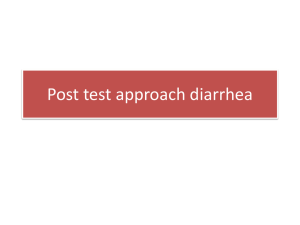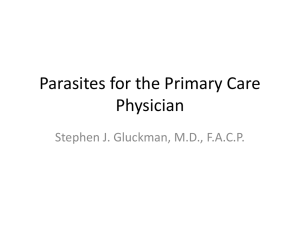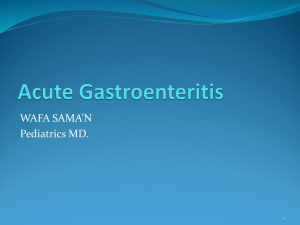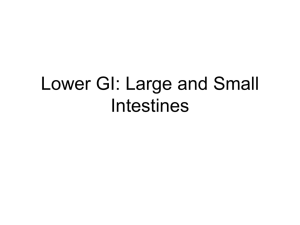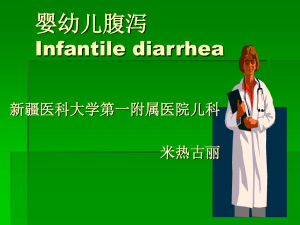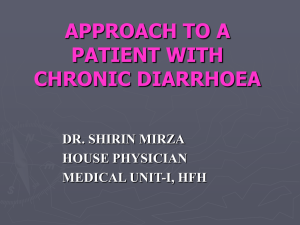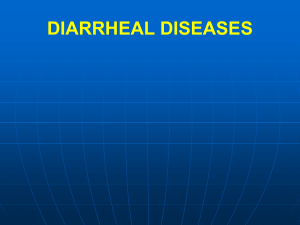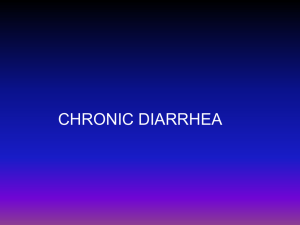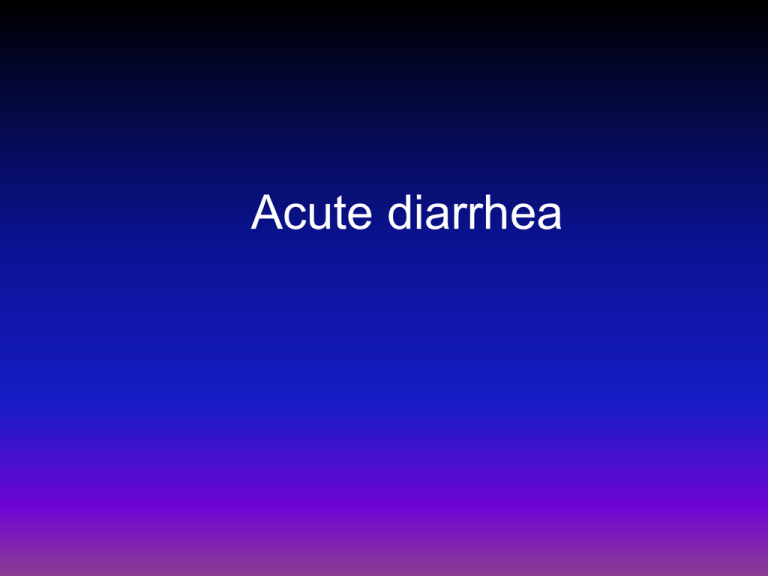
Acute diarrhea
DIARRHEA
DEFENITION
stool weight in excess of 200 grams per day.
Collecting and weighing stools is neither practical nor
required except in a clinical research setting.
A good working definition is three or more loose or
watery stools per day
A definite decrease in consistency and increase in
frequency based upon an individual baseline.
DIARRHEA
DEFENITION
Diarrhea reflects increased water content of the stool, whether
due to impaired water absorption and/or active water secretion
by the bowel.
In severe infectious diarrhea, the number of stools may reach
20 or more per day, with defecation occurring every 20 or 30
minutes. In this situation, the total daily volume of stool may
exceed two liters, with resultant volume depletion and
hypokalemia.
Most patients with acute diarrhea have three to seven
movements per day with total stool volume less than one liter
per day.
ETIOLOGY
Noninfectious
Drugs
Food allergies
Gastrointestinal diseases such as
inflammatory bowel disease
Other disease states such as
thyrotoxicosis and the carcinoid
syndrome.
Small bowel infections
watery diarrhea
Large volume
Abdominal cramping
Bloating, gas
Weight loss
Fever is rarely a significant symptom
Stool does not contain occult blood or
inflammatory cells.
Large intestinal diarrheas
Frequent,
Regular
Small volume
Often painful bowel movements.
Fever
Bloody or mucoid stools are common,
Red blood cells and inflammatory cells
may be seen routinely on the stool
smear.
ACUTE DIARRHEA
Definition
14 days in duration.
Persistent diarrhea — more than 14 days in
duration
Chronic — more than 30 days in duration
Agents that commonly cause
acute gastrointestinal illness
Bacteria
Salmonella
Campylobacter
Shigella
Escherichia coli 0157:H7
Clostridium difficile
Viruses
Calcivirused (Norovirus and related
viruses)
Rotavirus
Adenovirus types 40 and 41
Astrovirus
Protozoa
Cryptosporidium
Giardia
Cyclospora
Entamoeba histolytica
ETIOLOGY
Most cases of acute infectious gastroenteritis
are probably viral, in most studies, stool culture
has been positive in only 1.5 to 5.6 percent of
cases.
In contrast, bacterial causes are responsible for
most cases of severe diarrhea.
Protozoa are less commonly identified as the
etiologic agents of acute gastrointestinal illness.
DIAGNOSTIC APPROACH
Careful history to determine the duration of
symptoms
The frequency and characteristics of the stool
Evidence of extracellular volume depletion (eg,
decreased skin turgor, orthostatic hypotension).
Fever and peritoneal signs may be clues to
infection with an invasive enteric pathogen.
Indications for diagnostic
evaluation
Profuse watery diarrhea with signs of
hypovolemia
Passage of many small volume stools
containing blood and mucus
Bloody diarrhea
Temperature 38.5ºC (101.3ºF)
Passage of 6 unformed stools per 24 hours or
a duration of illness >48 hours
Severe abdominal pain
Recent use of antibiotics or hospitalized
patients
Diarrhea in the elderly (70 years of age) or the
immunocompromised
Small bowel
Colon
Bacteria :
Bacteria :
Salmonell
Escherichia coli
Clostridiu perfringens
Staphylococcus aureus
Aeromonas hydrophila
Bacillus cereus
Vibrio cholera
Campylobacter*
Shigella
Clostridium difficile
Yersinia
Vibrio parahaemolyticus
Enteroinvasive E. coli
Plesiomonas shigelloides
Klebsiella oxytoca (rare)
Small Bowel
Virus :
Rotovirus
Norovirus
Protozoa :
Cryptosporidium*
Colon
Virus :
Cytomegalovirus*
Adenovirus
Herpes simplex virus
Microsporidium*
Isospora
Cyclospora
Protozoa :
Giardia lamblia
Entamoeba
histolytica
Historical clue
Symptoms that begin within six hours suggest
ingestion of a preformed toxin of
Staphylococcus aureus or Bacillus cereus
Symptoms that begin at 8 to 16 hours suggest
infection with Clostridium perfringens
Symptoms that begin at more than 16 hours
can result from viral or bacterial infection (eg,
contamination of food with enterotoxigenic or
enterohemorrhagic E. coli
Recent antibiotic use
Fecal leukocytes and occult
blood
The variable estimates :may be partially due to
differences in specimen processing and in
operator experience. So the role has been
questioned
The presence of occult blood and fecal
leukocytes supports the diagnosis of a bacterial
cause of diarrhea in the context of the medical
history and other diagnostic evaluation
Bacterial culture in high risk patients.
Fecal leukocyte determination is probably not of
value in patients who develop diarrhea while
hospitalized, in whom testing for Clostridium
difficile is much more likely to be helpful
it is reasonable to continue symptomatic
therapy for several days before
considering further evaluation in patients
who do not have severe illness,
particularly if occult blood and fecal
leukocytes are absent
When to obtain stool cultures
Immunocompromised patients, including (HIV)
Patients with comorbidities that increase the
risk for complications
Patients with more severe, inflammatory
diarrhea (including bloody diarrhea)
Patients with underlying inflammatory bowel
disease in whom the distinction between a flare
and superimposed infection is critical
Some employees, such as food handlers,
occasionally require negative stool cultures to
return to work
When to obtain stool for ova and
parasites
Sending stool samples for ova and
parasites is not cost effective for the
majority of patients with acute diarrhea
indications for ova and parasite
study
Persistent diarrhea (associated with Giardia,
Cryptosporidium, and Entamoeba histolytica)
Persistent diarrhea following travel to special region
(associated with Giardia, Cryptosporidium, and
Cyclospora)
Persistent diarrhea with exposure to infants in daycare
centers (associated with Giardia and Cryptosporidium)
Diarrhea in a man who has sex with men (MSM) or a
patient with AIDS (associated with Giardia and
Entamoeba histolytica in the former, and a variety of
parasites in the latter)
A community waterborne outbreak (associated with
Giardia and Cryptosporidium)
Bloody diarrhea with few or no fecal leukocytes
(associated with intestinal amebiasis)
Endoscopy
Endoscopy is uncommonly needed in the diagnosis of acute
diarrhea. It may be helpful in the following settings:
Distinguishing inflammatory bowel disease from infectious
diarrhea
Diagnosing C. difficile infection and looking for
pseudomembranes in patients who are toxic while results of
tissue culture assays are pending. The widespread adoption of
enzyme linked immunosorbent assays (ELISA) for C. difficile
toxins A and B has reduced the time for C. difficile results to
become available and thus decreased the need for endoscopy
in these patients.
In immunocompromised patients who are at risk for
opportunistic infections with agents such as cytomegalovirus.
In patients in whom ischemic colitis is suspected but the
diagnosis remains unclear after clinical and radiologic
assessment.
TREATMENT
Oral rehydration solutions
Empiric antibiotic therapy
When to treat
Those with moderate to severe
travelers' diarrhea as
characterized by more than four
unformed stools daily, fever,
blood, pus, or mucus in the stool.
Those with more than eight stools per
day, volume depletion, symptoms for
more than one week
Those in whom hospitalization is
being considered and
immunocompromised hosts
Signs and symptoms of bacterial diarrhea such
as fever, bloody diarrhea (except, for suspected
EHEC or C. difficile infection),and the presence
of occult blood or fecal leukocytes in the stool
We recommend empiric therapy with an oral
fluoroquinolone (ciprofloxacin 500 mg twice
daily, norfloxacin 400 mg twice daily, or
levofloxacin 500 mg once daily) for three to five
days in the absence of suspected EHEC or
fluoroquinolone-resistant campylobacter
infection.
Azithromycin (500 mg PO once daily for three
days) and erythromycin (500 mg PO twice daily
for five days) are alternative agents particularly
if fluoroquinolone resistance is suspected .
Symptomatic therapy
The antimotility agent
loperamide (Imodium) may be
used for the symptomatic
treatment of patients with acute
diarrhea in whom fever is
absent or low grade and the
stools are not bloody. The dose
of loperamide is two tablets (4
mg) initially, then 2 mg after
each unformed stool, not to
exceed 16 mg/day for 2 days.
Diphenoxylate
Diphenoxylate (Lomotil) is an alternative
agent. The dose of diphenoxylate is two
tablets (4 mg) four times daily for 2 days.
has central opiate effects and may cause
cholinergic side effects.
Treatment with these agents may mask
the amount of fluid lost, since fluid may
pool in the intestine. Thus, fluids should
be used aggressively when antimotility
agents are employed.
Both drugs may facilitate the
development of the hemolytic-uremic
syndrome (HUS) in patients infected with
EHEC
Bismuth subsalicylate
(Pepto-Bismol)when compared with placebo
significantly reduced the number of unformed
stools and increased the proportion of patients
free of symptoms at the end of treatment trials
May be used in patients with significant fever
and dysentery, conditions in which loperamide
should be avoided.
The dose of bismuth subsalicylate is 30 mL or
two tablets every 30 minutes for eight doses.
Dietary recommendations
Adequate nutrition during an episode of acute
diarrhea is important to facilitate enterocyte
renewal if patients are anorectic
A short period of consuming only liquids will not
be harmful.
Boiled starches and cereals (eg, potatoes,
noodles, rice, wheat, and oat) with salt are
indicated in patients with watery diarrhea;
crackers, bananas, soup, and boiled vegetables
may also be consumed
SUMMARY AND
RECOMMENDATIONS
Several studies have evaluated the accuracy of
fecal leukocytes alone or in combination with
occult blood testing.
The ability of these tests to predict the presence
of an inflammatory diarrhea has varied greatly
We recommend obtaining stool cultures on
initial presentation in immunocompromised
patients (HIV-infected, elderly, patients with
comorbidities or with underlying inflammatory
bowel disease), those with severe or bloody
diarrhea, and in food handlers.
Shigella infection in adults
Shigella species are a common cause of
bacterial diarrhea worldwide,
The organism is not as susceptible to acid as
many other bacterial pathogens; thus, as few as
10 to 100 organisms can cause disease in part
because the organisms can survive transit
through the stomach .
Ingested bacteria pass into the small intestine
where they multiply, so that several logs more
bacteria pass into the colon, where the
organisms enter the colonic cells.
Shigella infection in adults
Shigella transmission can occur through
direct person-to-person spread as well
as from contaminated food and water;
the former accounts for most cases in
the United States while the latter is more
important in the developing world.
Shigella is a cause of classic dysentery
CLINICAL MANIFESTATIONS
Fever — 30 to 40 percent
Abdominal pain — 70 to 93 percent
Mucoid diarrhea — 70 to 85 percent
Bloody diarrhea — 35 to 55 percent
Watery diarrhea — 30 to 40 percent
Vomiting — 35 percent
CLINICAL MANIFESTATIONS
The incubation period one to seven
days, with an average of three days
Fever
Anorexia and malaise
Diarrhea initially is watery, but
subsequently contains blood and mucus.
Tenesmus is a common complaint.
CLINICAL MANIFESTATIONS
Stool frequency is typically eight to ten per day,
may increase to up to 100 per day.
Stools are of small volume, such that significant
fluid loss is uncommon (average approximately
30 mL/kg per day)
In a normal healthy host, the course of disease
is generally self-limited, lasting no more than
seven days when left untreated.
Major complications of Shigella
infection
Complication
Prevalance, percent
Intestinal :
Unknown
Proctitis or rectal
prolapse
Toxic megacolon
Intestinal obstruction
Colonic perforation
3
2.5
1
Major complications of Shigella
infection
Systemic:
Prevalance, percent
Bacteremia
4
Moderate to severe
10-12
hypovolemia
Hyponatremia
Leukemoid reaction
Neurologic symptoms
Reactive arthritis or Reiter's
Hemolytic-uremic syndrome
29
3
12-45
1.4
1
DIAGNOSIS
Frequent, small volume, bloody stools,
Abdominal cramps, and tenesmus, particularly
if accompanied by fever.
Nausea and vomiting are notably absent in
most patients
Fecal leukocytes are generally present.
DIFFERENTILA DIAGNOSIS
Shigella
Salmonella
Campylobacter
Yersinia
Enteroinvasive E. coli
Clostridium difficile
Noninfectious inflammatory bowel
disease
Fecal leukocytes
Is associated with a bacterial cause of
acute diarrhea in 89 percent of cases .
had fecal leukocytes (all of which were
polymorphonuclear leukocytes) in 70 to
100 percent of samples tested, with at
least 10 to 25 cells/hpf in the majority of
patients .
In comparison, healthy controls and
patients with cholera or viral diarrhea
had no fecal leukocytes.
Stool culture
Definitive determination by stool culture
Sheigla requires prompt handling and
optimally should be inoculated onto agar
at the bedside.
Culture from a stool sample may give a
better yield than culture from a rectal
swab

